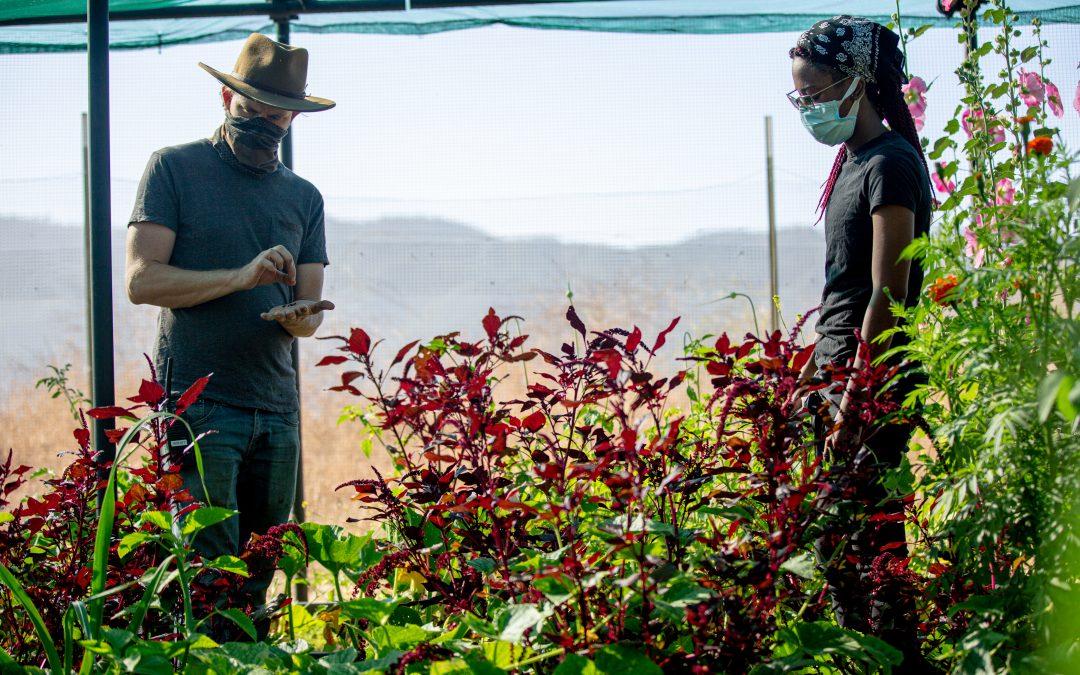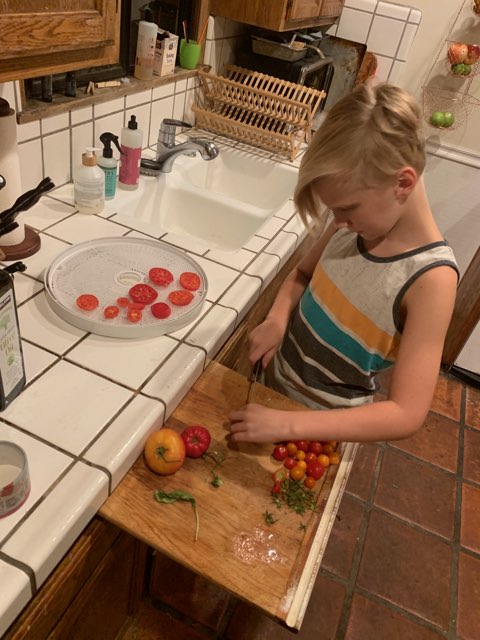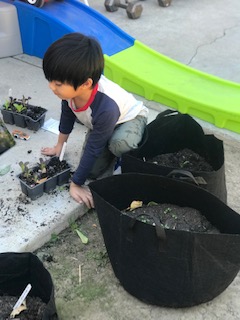By. Rick Perillo
Last January, lunch at MUSE School in Calabasas, California reflected our school values. Students would line up for a plant-based lunch that included a main course and a salad bar full of organic vegetables, nuts and seeds, and local seasonal fruit. Most of the food was grown just steps away in the gardens on campus. Our students played an active role in the growing process, seeding, planting, and harvesting the abundance of produce. MUSE School is a passion-based learning school where students have voice and choice in the projects they pursue. It’s not uncommon for students to choose projects that involve either the gardens or cooking (or both). A MUSE student might choose baking as their passion project and get one-on-one time in the kitchen learning how to make cranberry scones.
Due to COVID-19, MUSE School is now entirely online. Our students, educators, and staff are cut off from the school kitchen, gardens, oak trees, and, in many ways, each other. As a garden educator, my goal to guide students in making connections between the health of the soil, our planet, and ourselves has been challenged. When we first moved online, I grew discouraged as I watched students drink out of disposable water bottles or eat Chick-fil-A during class.
However, students did reach out to me over Zoom, wanting to know if they should buy a Douglas fir or redwood for the garden beds they were going to make. One fifth-grade student showed me his book on wild edible plants and rattled off the names of plants he had identified in his neighborhood: stinging nettle, wood sorrel, lamb’s quarters. Students also asked questions about what they saw in the background at my house during a Zoom class. They would ask me, “What is that jar full of things that look like brains?” I would show them my jar of SCOBYs and explain how I make my own kombucha. I would show them the fruit trees in my yard and the chickens who scratch around under them. We would run experiments as a class in my hydroponic tower. They saw I was a learner just like them, always tinkering, making mistakes, and growing.
A major goal of my class had always been to inspire students to grow something at home, whether it be a few chives in a pot or a garden bed full of vegetables. I wanted my students to enter their kitchens with confidence and see that there are more tools available to them other than the microwave. With students now learning remotely, I saw this as an opportunity to connect them with the outdoor spaces around their homes while satisfying their curiosity about where food comes from.
In spring 2020, I began to put together a unit for my high school students on food preservation. It seemed like an opportune time to learn about food security and the ancient art of preserving food, especially given the long lines at grocery stores. We made pickles, kimchi, cashew cheese, and fruit leather. It was a challenge for many students to be ready with their ingredients on cooking days. We had the most success when we kept it simple and flexible. Fruit leather can be made with just about any fruit, so some unprepared students went to their fridge at the last minute and were able to pull off the project with a pack of frozen strawberries or a few apples on the kitchen counter.
Students were also required to choose a food preservation project to complete independently and present to the rest of the class. Some took the opportunity to learn about a family tradition such as Nopalitos en vinagré and pickled carrots. Other students learned how to make their own jams from backyard fruit trees. One student made eggplant bacon just because he likes bacon.
This unit ran concurrently with a unit on regenerative agriculture. We took virtual tours of large industrial corn farms that use giant John Deere machinery to plant seeds by GPS. Then, we toured small organic farms that grow a variety of produce using compost and regenerative methods. Students compared the different systems in their journals and discussed their thoughts and feelings. In this way, they began to look past our school gardens to understand the complexity of the food supply chain and the importance of how our food is grown.
Meanwhile, to compliment the younger students’ science standards, our Kindergarten, first-, and second-grade students sprouted bean seeds in pots at home. The purpose was to observe and journal the lifecycle of a plant. They excitedly watched their plant’s growth and enjoyed showing off their progress each week. Some students even got a few beans to snack on out of it.
Third- and fourth-graders explored compost and worm bins. I set up an experiment with three plants, one fertilized with worm castings, another with compost, and one without anything. Every two weeks, students would observe the plants through my screen and record the plants’ progress in their journals. They practiced using adjectives to describe the plants, such as lush, leggy, and radiant. It wasn’t meant to be a competition, but the students turned it into one with worm castings coming in as the clear winner.
We also started “zombie gardens” where we took parts from old plants – a carrot top, lettuce bottom, garlic clove – and grew new plants from them. This can be done with recycled yogurt cups as pots, a little soil, and vegetable clippings that normally go in the trash. Students loved seeing their plants come back to life and began to understand the resilience and vitality of nature.
At MUSE, students often work one-on-one with a mentor as they complete their passion projects. We’ve continued this keystone aspect of our school virtually. For example, a fifth-grader chose sushi for his passion project. We explored the history and different methods of growing rice. We studied local entrepreneurs growing seaweed more sustainably. We experimented with making pickled ginger (not quite the same as in sushi restaurants). For our final meeting, our school chef led us through making plant-based sushi. In another instance, a first-grader wanted to start a garden at his home. Using simple grow bags, I guided him as he filled the bags, planted seeds, labeled them, and cared for his plants. He is currently growing lettuce, mustard greens, kale, and bok choy. Our goal is to use the harvest to make dumplings.
Before the pandemic, I might make a massaged kale salad with students who would be trying kale for the first time. They would exclaim that they loved it, but I wondered if they would repeat the process at home. Now they are home, and I have the opportunity to bring these lessons into their domain. In the process, I am helping to demystify their kitchens, encouraging students to rummage in their spice cabinets, participate in weekly meal planning, and plant a few herbs on the windowsill or even start a backyard garden. We will move past COVID-19 one day, but I hope we always remember to get our hands in the soil, experiment with new recipes, and turn off the computer and sit down for a meal.
Author Bio
Rick Perillo has been exploring and teaching ecological gardening practices since graduating from California State University, Northridge in 2006. He has worked on organic farms in New Zealand and Colorado, as well as earned two Permaculture Design Certificates, his Master Gardener Certificate, and a Certificate in Global Sustainability from UCLA. Rick has taught ecological gardening at MUSE School for the last seven years. Read more of Rick’s writing at www.thecarrotrevolution.com.



